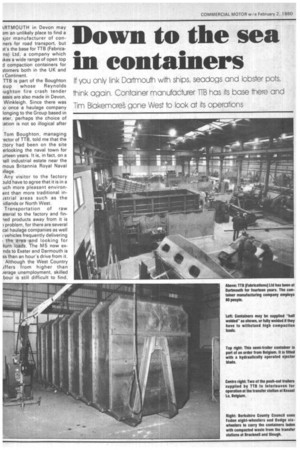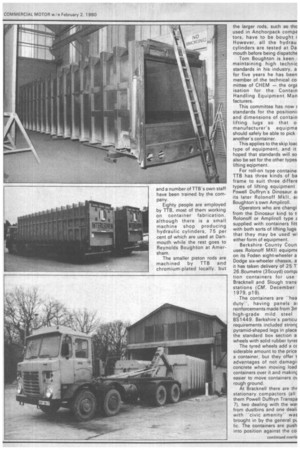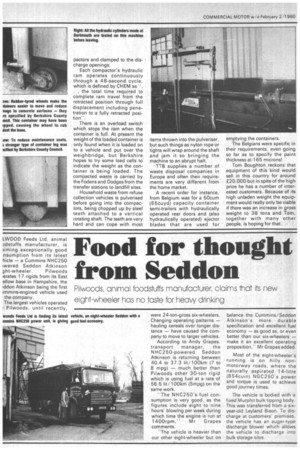Down to the sea in containers
Page 38

Page 39

Page 40

If you've noticed an error in this article please click here to report it so we can fix it.
If you only link Darmo with ships, seadogs anc lobster pots, irk again. Container manufacturer I IB has its base ere and Tim Blakemore's gone West to look at its operations
kRTMOUTH in Devon may tm an unlikely place to find a 3 jor manufacturer of conners for road transport, but ifs the base for TTB (Fabricans) Ltd, a company which ikes a wide range of open top d compaction containers for 5tomers both in the UK and Continent.
TTB is part of the Boughton oup whose Reynolds .ughton fire crash tender assis are also made in Devon, Winkleigh. Since there was .0 once a haulage company longing to the Group based in eter, perhaps the choice of :ation is not so illogical after
Tom Boughton, managing .ector of TTB, told me that the ..:,tory had been on the site erlooking the naval townfor Jrteen years. It is, in fact, on a Ian industrial estate near the mous Britannia Royal Naval )1Iege.
Any visitor to the factory ul d have to agree that it is in a uch more pleasant environent than more traditional inistrial areas such as the idlands or North West.
Transportation of raw aterial to the factory and finled products away from it is ) problem, for there are several cal haulage companies as well ; vehicles frequently delivering the area and looking for turn loads. The M5 now exnds to Exeter and Darmouth is ss than an hour's drive from it. Although the West Country Jffers from higher than rerage unemployment, skilled bour is still difficult to find, the larger rods, such as tho used in Anchorpack compe tors, have to be bought i However, all the hydrau cylinders are tested at Da mouth before being dispatche Tom Boughton is keen maintaining high technic standards in his industry, a for five years he has been member of the technical co mine° of CHEM — the orge isation for the Contain Handling Equipment Man facturers.
This committee has now standards for the positionii and dimensions of contain lifting lugs so that ol manufacturer's equipme should safely be able to pick I another's container.
This applies to the skip loac type of equipment, and it hoped that standards will so also be set for the other types lifting eqipment.
For roll-on type containe TTB has three kinds of ba frame to suit three differe types of lifting equipment Powell Duffryn's Dinosaur ai its later Rolonoff MkII, ar Boughton's own Ampliroll.
Operators who are changi from the Dinosaur kind to ti Rolonoff or Ampliroll type supplied with containers fitt with both sorts of lifting lugs that they may be used wi either form of equipment.
Berkshire County Coun uses Rolonoff MICH equipmc on its Foden eight-wheeler a Dodge six-wheeler chassis, a it has taken delivery of 25 T 26.8cumetre (35cuyd) comm tion containers for use Bracknell and Slough trans. stations (CM, December 1979, p19).
The containers are "hea duty", having panels ai reinforcements made from 3rr high-grade mild steel BS1449. Berkshire's particu requirements included strone pyramid-shaped legs in place the standard box section a wheels with solid rubber tyres The tyred wheels add a cc siderable amount to the price a container, but they offer t advantages of not damagil concrete when moving load containers over it and makine easier to move containers c\ rough ground.
At Bracknell there are thr stationary compactors (all them Powell Duffryn Transpa 7), two dealing with the wa5 from dustbins and one deali with "civic amenitywas brought in by the general pr. tic. The containers are push into position against the co
pactors and clamped to the discharge openings.
Each compactor's hydraulic ram operates continuously through a 48-second cycle, which is defined by CHEM as . . the total time required to complete ram travel from the retracted position through full displacement including penetration to a fully retracted position".
There is an overload switch which stops the ram when the container is full. At present the weight of the loaded container is only found when it is loaded on to a vehicle and put over the weighbridge, but Berkshire, hopes to try some load cells to indicate the weight as the container is being loaded. The compacted waste is carried by the Foderis and Dodges from the transfer stations to landfill sites.
Household waste from refuse collection vehicles is pulverised before going into the compactors, being chopped up by steel teeth attached to a vertical rotating shaft. The teeth are very hard and can cope with most items thrown into the pulveriser, but such things as nylon rope or tights will wrap around the shaft and jam it so bringing the machine to an abrupt halt.
TTB supplies a number of waste disposal companies in Europe and often their requirements are very different from the home market.
A recent order for instance, from Belgium was for a 50cum (65cuyd) capacity container semi-trailers with hydraulically operated rear doors and (also hydraulically operated) ejector blades that are used for emptying the containers.
The Belgians were specific in their requirements, even going so far as to specify the paint thickness at 165 microns!
Tom Boughton reckons that equipment of this kind would sell in this country for around £20,000 but in spite of the high price he has a number of interested customers. Because of its high unladen weight the equipment would really only be viable if there was an increase in gross weight to 38 tons and Tom, together with many other people, is hoping for that.








































































































































